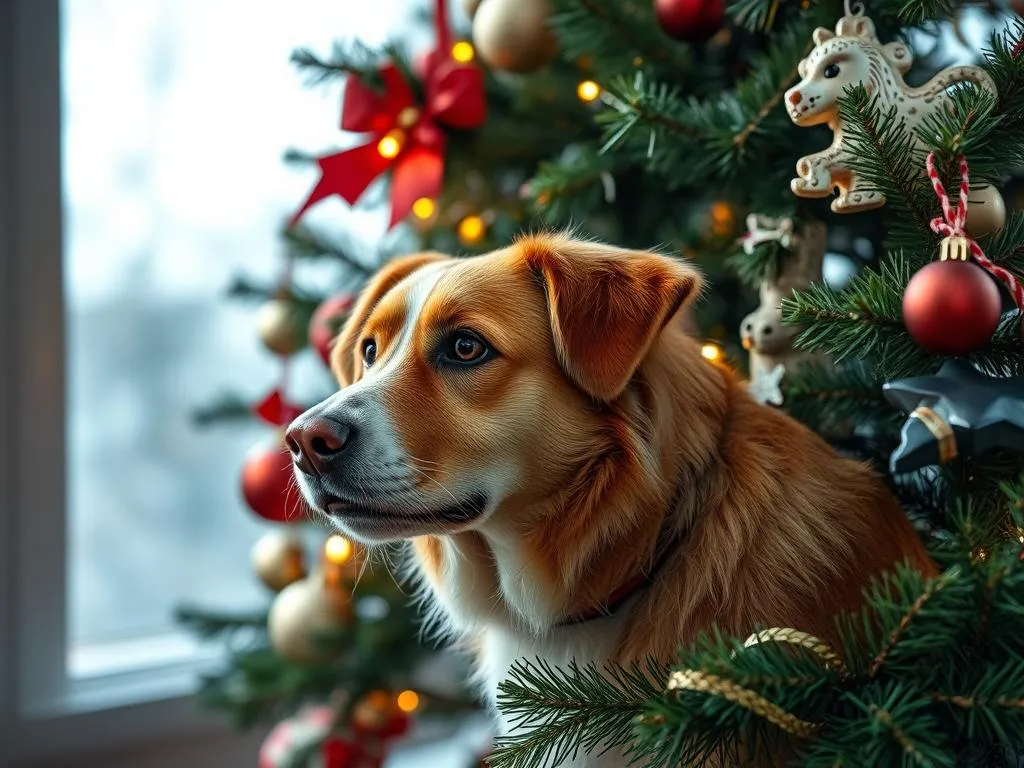
The holiday season brings joy and celebration, but it also poses unique challenges for dog owners. One of the most significant sources of concern is the Christmas tree, which can present various hazards to our furry friends. Understanding the potential dangers and taking proactive measures is essential in ensuring a safe environment for both pets and families.
Understanding the Risks
Common Hazards of Christmas Trees
When it comes to the Christmas tree, several hazards can threaten your dog’s health and safety.
-
Ingestion of Ornaments and Decorations: Ornaments, tinsel, and other decorations can be tempting for dogs. The shiny, colorful objects may attract their attention, leading to accidental ingestion, which can cause gastrointestinal blockages or other serious health issues.
-
Risks of Sharp Objects: Many decorations, especially glass ornaments, can shatter and create sharp shards that can injure a curious pup. Ingesting these shards can lead to cuts, internal injuries, or even severe bleeding.
-
Toxic Plants: Certain holiday plants, such as poinsettias, holly, and mistletoe, are toxic to dogs. If ingested, these plants can cause a range of symptoms, from mild gastrointestinal upset to more severe reactions that might require veterinary attention.
Behavioral Changes in Dogs During Holidays
During the holiday season, dogs often exhibit behavioral changes due to the excitement and alterations in their environment.
-
Increased Curiosity and Excitement: The presence of a Christmas tree can tempt dogs to explore, leading to risky behaviors. They may jump, claw, or even try to climb the tree, which can result in injuries or accidents.
-
Changes in Routine and Environment: The influx of holiday guests and the overall hustle and bustle can create anxiety or stress in dogs. Changes in their daily routine can lead to confusion, causing them to act out in ways that might put them at risk.
Preparing Your Home
Choosing the Right Tree
When it comes to selecting a Christmas tree, there are pros and cons to consider between real and artificial trees.
-
Real Trees: While they offer a traditional holiday feel, they can drop needles that might irritate a dog’s paws or gastrointestinal tract if ingested. Additionally, some real trees can have mold or sap that may be harmful.
-
Artificial Trees: These are generally safer in terms of ingestion and allergies, but they can still pose risks if they are not secured properly.
Consider placing the tree in a low-traffic area to minimize the risk of your dog getting too close.
Securing the Tree
Once you’ve selected your tree, it’s crucial to secure it adequately.
-
Stabilizing the Tree: Make sure the tree is firmly anchored in its stand. Use additional weights or straps if necessary to prevent it from tipping over if your dog gets too close.
-
Using Barriers: Installing baby gates around the tree can create a physical barrier, helping to keep your dog at a safe distance. This is especially useful if your dog is particularly curious or spirited.
-
Avoiding Heavy Decorations on Lower Branches: Place heavier ornaments higher up on the tree. This minimizes the risk of them falling and being broken, which could injure your pet.
Training Your Dog
Basic Commands for Safety
Training your dog to respond to basic commands can be invaluable during the holiday season.
- Teaching Commands Like “Leave It” and “Stay”: These commands can prevent your dog from approaching the Christmas tree and its decorations. Consistency is key, so practice regularly and reinforce good behavior with treats and praise.
Redirecting Attention
Providing alternative distractions can help keep your dog’s focus away from the tree.
-
Offering Toys and Chews: Keep a variety of toys and chews accessible to your dog. This will help to engage them and divert their attention from the holiday decorations.
-
Engaging in Interactive Games: Spend time playing games with your dog, such as fetch or hide and seek, to keep their energy directed toward healthy activities.
Creating a Safe Space
Designating Dog-Free Zones
Creating a comfortable area for your dog can help them feel secure during the busy holiday season.
- Setting Up a Comfortable Area: Consider setting up a cozy dog bed, crate, or playpen in a quiet part of your home away from the Christmas tree. This can provide a safe haven where your dog can relax and feel secure.
Monitoring and Supervision
Keeping an eye on your dog is crucial, especially during gatherings.
- Utilizing Technology: Pet cameras can be beneficial for monitoring your dog’s behavior when you’re not around. This allows you to intervene if your dog begins to approach the tree or engage in unsafe behavior.
Holiday Pet Care Tips
Diet and Nutrition
Maintaining your dog’s diet during the holiday season is vital for their health.
-
Regular Feeding Routines: Stick to your dog’s regular feeding schedule to avoid upsetting their digestive system. It’s easy to get distracted during holiday feasts, but consistency is key.
-
Avoiding Holiday Foods: Many traditional holiday foods can be harmful to dogs. Foods like chocolate, grapes, onions, and fatty meats should be kept out of reach to prevent accidental ingestion.
Exercise and Routine
Keeping up with your dog’s exercise routine is essential to their well-being.
-
Regular Walks and Playtime: Maintain daily walks and playtime to help your dog burn off energy. This not only keeps them physically fit but also reduces the likelihood of them getting into mischief around the Christmas tree.
-
Stability Amidst Holiday Chaos: Try to maintain a stable routine amidst the holiday chaos. Dogs thrive on consistency, and keeping their schedules as regular as possible can help mitigate stress.
Emergency Preparedness
Recognizing Signs of Distress
Being aware of your dog’s behavior can help you identify potential issues early.
-
Symptoms of Ingestion of Harmful Items: If your dog has ingested something harmful, symptoms may include vomiting, diarrhea, lethargy, or abdominal pain. If you notice any of these signs, it’s essential to contact your veterinarian immediately.
-
Behavioral Signs of Stress or Anxiety: Changes in behavior, such as excessive barking, hiding, or destructive tendencies, can indicate that your dog is feeling stressed. It’s crucial to address these issues promptly.
Having a Plan
Preparation can make all the difference in an emergency.
-
Creating an Emergency Contact List: Keep a list of important contacts, including your vet and the local animal poison control center. Having this information readily available can save precious time in a crisis.
-
Ensuring Easy Access to First Aid Supplies: Assemble a pet first aid kit that includes essentials like bandages, antiseptic wipes, and any medications your dog may need. This ensures you’re prepared for any minor injuries or emergencies that might arise.
Conclusion
The holiday season is a time for joy and celebration, but it’s essential to prioritize dog health care, especially when it comes to keeping your furry friends safe from potential hazards such as the Christmas tree. By understanding the risks, preparing your home, training your dog, and creating a safe environment, you can ensure that both your family and your pets enjoy a festive and safe holiday season.
Taking the time to implement these strategies will not only protect your dog but also contribute to a more relaxed and enjoyable atmosphere for everyone. Remember, a little preparation goes a long way in ensuring that your pet remains happy and healthy throughout the holidays.









